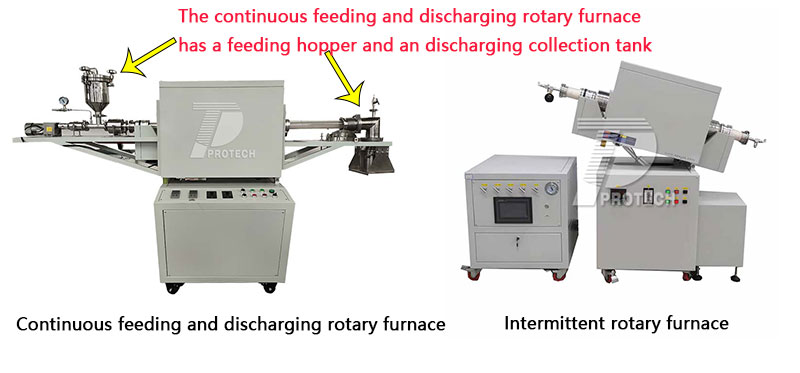


NEWS
There are significant differences between intermittent rotary furnaces and continuous rotary furnaces in terms of working methods, working principles, and applicable scenarios.
1. Product structure:
Intermittent rotary furnace mainly consists of furnace body, furnace cover, rotating mechanism, heating elements, cooling system, and other parts. The furnace body is usually made of refractory materials and can withstand high temperature and high pressure. There are observation holes and feeding ports on the furnace cover, which facilitate operators to observe the situation inside the furnace and add raw materials. The rotating mechanism is the core part of the rotary furnace, which can rotate the furnace body within a certain angle range, thereby achieving uniform heating and cooling of materials. Its working principle is to continuously rotate the furnace body during the heating process through a rotating mechanism, so as to evenly heat the materials inside the furnace. When the material is heated to the desired temperature, the rotating mechanism will stop working and the furnace body will enter the insulation stage. After the material is processed, the rotating mechanism starts again to rotate the furnace to the cooling position, and then the heat inside the furnace is quickly discharged through the cooling system, allowing the material to cool and solidify quickly.
The characteristics of a continuous rotary furnace lie in its continuity and automated working mode. It can meet the requirements of high sealing accuracy and is suitable for the roasting reactions of inorganic salt powder materials, metal powders, etc. in oxidizing or reducing atmospheres. It is also suitable for the oxidative treatment of catalyst carriers in the chemical industry, as well as high-tech materials such as graphene, nanomaterials, rare earths, etc. During the heat treatment process, the rotary cylinder has a small inclination, and loose solids continuously move from the feed end to the discharge end in the kiln. The kiln is generally operated continuously and automatically. They can directly transport bulk solids without the need for further conveying equipment, making these kilns more energy-efficient.

Appearance differences between continuous feeding and intermittent rotary furnaces
2. Operation method:
Intermittent rotary furnace: The working cycle is short, usually stopping after one operation and waiting for the next operation. The operation process usually includes stages such as heating, insulation, cooling, and sampling.
Continuous rotary furnace: With a long working cycle, it usually does not stop working after a single operation is completed, but runs continuously. The sample is continuously passed through the furnace, completing processes such as heating, insulation, and cooling.
3. Working principle:
Intermittent rotary furnace: The sample is heated, insulated, and cooled in the furnace. After each operation is completed, the furnace needs to stop working and wait for the next operation.
Continuous rotary furnace: The sample is continuously heated, insulated, and cooled inside the furnace, and the entire process is continuous.
4. Applicable scenarios:
Intermittent rotary furnace: suitable for situations where separate sample processing is required and the process requirements are relatively flexible. For example, conducting deep heat treatment or research experiments on small batches of samples.
Continuous rotary furnace: suitable for continuous processing of large batches of samples and with relatively stable process requirements. For example, industrial production on large-scale production lines.
5. Efficiency and production capacity:
Intermittent rotary furnace: Low production efficiency, suitable for processing small batch samples, but with flexibility and adjustability.
Continuous rotary furnace: With high production efficiency, it can continuously process large batches of samples and is suitable for high-yield industrial production environments.
In summary, the main difference between intermittent and continuous rotary furnaces lies in their working methods: intermittent is batch processing, and after each batch of materials is processed, they need to be cooled and re fed; The continuous type achieves continuous material handling and roasting processes, with a high degree of automation and greater energy efficiency. The specific type of rotary furnace to choose needs to be comprehensively considered based on production needs, material characteristics, and economic benefits. The selection of the appropriate type depends on actual needs, including the number of processed samples, flexibility and stability of process requirements, as well as production efficiency and other factors.Click to learn more Rotary tube furnace! Or click on online customer service to learn more about product information!
Leave A Message